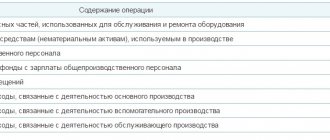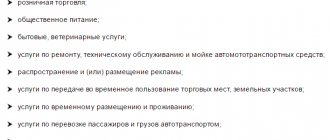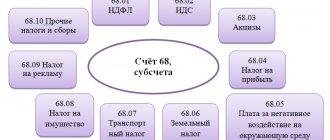Subaccounts 91 accounts:
- 91.1 “Other income” - 91 1 accounting account is intended to reflect various income transactions for non-core activities of the company. An exception is extraordinary income of the organization.
- 91.2 “Other expenses” - account 91 2 in accounting is used to reflect transactions on expenses not related to the main activities of the business.
- 91.9 “Balance of other income/expenses - the account is intended for monthly calculation of the balance of 91 accounts. in order to close it. At the same time, the balance of the remaining sub-accounts continues to “hang”, which allows you to obtain information about the accumulated balances at any time. Closing with final transactions is written off to the debit or credit of the savings account. 99.
The financial characteristics of account 91 “Other income and expenses” make it possible to obtain generalized information on those operations of the company that are not directly related to the main types of OKVED. As a rule, such operations do not greatly affect the financial results of a business, but are nevertheless important for calculating reliable data on income, costs, and profits. Information can be presented in a generalized form or with analytics by types of income and expenses.
Account 91 in accounting
Often in the economic life of a company there is a need to carry out operations not related to the main activities.
Moreover, income received from such operations, as well as costs aimed at performing other types of activities, cannot be included in the main income and expenses; they are subject to separate reflection in accounting.
We will tell you how to correctly account for other income and expenses in our article.
ConsultantPlus TRY FREE
Get access
Income receipts from sales and expense transactions related to the main activity of the enterprise are subject to reflection in accounting account 90 “Sales”. But income and expenses from other activities cannot be reflected on the sales account. In accordance with Order of the Ministry of Finance No. 94n, such transactions should be accumulated in a special account 91 in accounting.
Let us remind you that other types of operations include the following:
| Income | Expenses |
|
|
Accounting account 91 is intended to reflect income from other types of credit activities and debit expenses.
Account details 91
For additional detailing of analytical accounting for business operations from other types of activities, the opening of special sub-accounts is provided:
- 91-1 “Other income” (PD);
- 91-2 “Other expenses” (PR);
- 91-3 “VAT”;
- 91-9 “Balance of other income and expenses.”
Please note that, taking into account the specifics of the company’s activities, additional sub-accounts may be opened. So, for example, you can further detail account 91-2 by type of other expenses. However, such a decision must be fixed in the accounting policies of the organization.
Typical accounting entries 91
Let's consider the main accounting entries for reflecting business transactions with other income and expenses:
| Debit | Credit | |
| Receipt of PD to settlement accounts or to the company’s cash desk | 5150 | 91-1 |
| PD for settlements with customers is reflected | 62 | 91-1 |
| PD for settlements with various debtors and creditors was taken into account | 76 | 91-1 |
| Value added tax is charged for other transactions | 91-3 | 68 |
| Reflected PR upon disposal of fixed assets | 91-2 | 01 |
| DP taken into account when disposing of inventories or raw materials | 91-2 | 10 |
| Accepted for accounting of PR for settlements with suppliers and contractors | 91-2 | 62 |
| Disposals from the company's settlement accounts for PR operations are reflected | 91-2 | 51 |
Note that accounting account 91 at the end of the reporting month should not have any balances, that is, this accounting account should be closed.
How to close account 91
At the end of the reporting month, the other expenses account (account 91) should not have a balance either in debit or credit. Therefore, on the last day of the reporting month, an accounting entry should be generated that closes accounting account 91, with the difference in business transactions assigned to the profit and loss account.
Accounting entry, how to close 91 accounts:
- If a profitable (positive) balance has been formed for other transactions, entry Dt 91-9 Kt 99 is drawn up.
- If an unprofitable (negative) balance is identified based on account turnover for the month, then the accountant must reflect the posting Dt 99 Kt 91-9.
At the end of the financial year, before preparing financial statements, it is necessary to check the closure of all sub-accounts of 91 accounting accounts.
Source: https://ppt.ru/info/plan-schetov/91
Typical transactions for account 91:
- D account 91 02 K 66, 67 – the accrual of credit percentage is reflected.
- D 91.02 K 10 – reflects the write-off of inventory items upon disposal.
- D 91.09 K 99 – the closing of the account balance is reflected.
- D 91.02 K 70 – reflects the accrual of semi-annual bonuses to staff.
- D 10 (41, 01) K 91.01 - surplus inventory, goods, fixed assets were identified.
- D 76 K 91.01 – reflects the accrual of interest on bonds.
- D 91.02 K 76 – reflects the accrual of the commission for the bank’s cash settlement services.
- D 51 K 91.01 – reflects the receipt of penalties for non-compliance with contractual terms.
How to write off VAT correctly in the 1s program?
The activities of each organization on the general taxation system are associated not only with the shipment of products or the provision of services, but also with the acquisition of materials, services and works from suppliers and accounting.
If counterparties - VAT payers can officially confirm the sale of their products, works or services with invoices (universal transfer documents), then the organization has the right to write off the amount of its own tax at the expense of “incoming”. In other words, the legislation provides the opportunity to deduct (write off) VAT charged by suppliers and sellers from the total amount of tax liabilities, that is, not to pay it.
On what basis is the submitted VAT written off?
To apply the legal right to write off a certain amount of value added tax, the corresponding business transaction with a counterparty must be confirmed by an invoice, a delivery note, or a certificate of work performed (services rendered).
The right to a tax deduction and making appropriate accounting entries arises only when:
- All received goods have been capitalized;
- The work is completed, the services are provided and reflected in the accounting records;
- The delivery of all purchased materials and execution of work is accompanied by up-to-date invoices.
The right to deduct input value added tax appears upon mandatory confirmation of a business transaction with an invoice (universal transfer document) of the counterparty, drawn up in accordance with the requirements of Art. 169 of the Tax Code of the Russian Federation.
If the invoice is drawn up incorrectly or is missing, then the tax received cannot be deducted. In this situation, the tax is included in other expenses and cannot be taken into account in tax accounting. If the company is not a value added tax payer, then its amount increases the cost of goods sold.
In what cases is the “VAT write-off” document used?
In the 1C: Accounting 8 (rev. 3.0) program, deduction of the tax presented by the counterparty is implemented using the document “Write-off of VAT”, which involves manually assigning the received tax to expenses. It is entered on the basis of “Receipt of goods and services” and is filled in automatically according to the data in the “VAT presented” register, containing subaccount 19 of the account.
Write-off of value added tax may be required, for example, when purchasing goods and other valuables by an accountable person. The tax amount is indicated on the sales receipt, but an invoice is not provided.
When preparing an advance report for the receipt of goods, works or services, the incoming value added tax is by default applied to other costs, without reducing the profit tax base.
Sometimes, instead of being deducted or included in the value, the received value added tax must be attributed to certain accounts. For example, such a need arises when:
- VAT should be written off to 91 accounts instead of the account for the receipt of valuables, works or services, and therefore its amount cannot be included in the price, for example, when there is no seller’s invoice;
- The organization charges employees the cost of a number of services for the amount used in excess of the limit. In this case, VAT in the given proportions is charged to account 73;
- When rationing advertising costs, VAT must be deducted when recognizing costs for tax purposes. In this situation, the remaining tax amount at the end of the year is written off to 91 accounts;
- It is necessary to adjust the balances on account 19 due to errors in previous periods.
Such transactions are reflected in the document “Write-off of VAT”. In the 1C: Accounting 8 (rev. 3.0) program it is now possible to enter its data on receipts, which significantly simplifies this process and allows you to accurately fill in all the necessary details.
Examples of transactions on accounts. 91:
- Example 1. “Account 91 1 to reflect the receipt of rental income” - the company provides premises for rent. The monthly receipt of money for rent is reflected using entry D 62 K 91.01 for the amount of the rent.
- Example 2. “Account 91 2 to reflect the write-off of commissions for banking services” - such operations can be carried out directly through the account. 91 by posting D 91.02 K 51 or through account 76 indicating the bank - D 76 K 51 for the amount of cash settlement, and then D 91.02 K 76.
- Example 3. “Account 91 1 to reflect income from the sale of MC” - the sale of materials is recognized as other income, therefore all operations are carried out through 91 accounts. The entries are as follows: D 62 K 91.01 – the sales amount is reflected, D 91.02 K 10 – the write-off of the cost of the MC is reflected, D 91.VAT K 68.VAT – the tax is allocated.
Account 91 in accounting: Other income and expenses
Accounting account 91 is an active-passive account “Other income and expenses”, used to obtain information about the expenses and income of the enterprise for activities that are not the main one. Using standard postings and practical examples, we will consider the specifics of using account 91 and the features of accounting for other income and expenses.
Closing 91 accounts
All subaccounts under the “Other income and expenses” account at the end of the year: balance for December, internal records - must be closed by posting to subaccount 91.09.
The financial result is credited to the debit (loss) or credit (profit) of account 99 “Profits and losses”.
Here is a schematic example of closing 91 accounts:
Postings to 91 accounts “Other income and expenses”
Correspondence and main transactions for 91 accounts are shown in the table:
| Dt | CT | Wiring Description | A document base |
| 91 | 01 | Write-off of retired fixed assets at residual/initial value. | OS-1, SP-51 |
| 91 | 02 | Calculation of depreciation on fixed assets that are leased (not an object of activity). | Accounting statement, Depreciation sheet |
| 91 | 03/04 | Write-off of retired income-generating investments in tangible assets (hereinafter referred to as MT)/intangible assets. | Accounting certificate, Acceptance certificate |
| 91 | 07 | Write-off of equipment for installation (sold/transferred free of charge) at cost. | Acceptance certificate, Invoice |
| 91 | 08 | Write-off of the cost of investments in VNA. | Certificate of acceptance and transfer, Certificate of gratuitous transfer of valuables |
| 91 | 10 | Write-off of materials sold/transferred free of charge (upon disposal of fixed assets) at actual cost. | Acceptance certificate, Invoice |
| 91 | 11 | Write-off of the cost of sold animals (not an activity item). | TTN (SP-32) |
| 91 | 14/59/63 | Creation of a reserve to reduce the value of the capital asset/ensure investments in securities/for doubtful debts. Write-off of amounts to reserves – by reverse posting. | Accounting certificate, accounting calculation for creating a reserve |
| 91 | 15 | Reflection of write-off of materials (actual cost). | Acceptance certificate, Invoice |
| 91 | 16 | Write-off of the share of deviations from the accounting cost of materials sold (if a negative value - a red reversal). | Accounting certificate, accounting calculation for writing off deviations |
| 91 | 19 | Write-off of VAT on materials sold (non-refundable). | Accounting information |
| 91 | 20/21/23 Get 267 video lessons on 1C for free:/29 | Write-off of expenses for maintaining production facilities/facilities for conservation. | Accounting certificate, accounting calculations |
| 91 | 23 | Write-off of the cost of services of auxiliary production (upon disposal of fixed assets). | |
| 91 | 28 | Write-off of the cost of irreparable defects (work of an operational nature). | |
| 91 | 43 | Write-off of commercial expenses (for the sale of operating systems, materials). | |
| 91/19 | 60 | Reflection of amounts accrued by the contractor for work/services performed upon liquidation/sale of fixed assets, other assets/VAT amount. | Invoice |
| 91 | 60/62/76 | The amount of receivables/debt is written off after the expiration of the statute of limitations/ cannot be recovered in any way. | INV-17, Accounting certificate, Minutes/order of the manager |
| 91 | 66/67 | Reflection of the percentage amount payable for using credits/loans. | Accounting certificate, Bank account statement |
| 91 | 68 | VAT accrual (income from the sale of operating systems/materials). | Accounting certificate, VAT accounting calculation |
| 91 | 70/69/10 | Reflection of expenses for liquidation of OS-v. | Work order for piece work, Certificate of write-off of valuables |
| 91 | 75 | Reflection of expenses (simple partnership agreement). | Accounting certificate-calculation |
| 91 | 51/76 | Reflection of violations of the terms of business contracts (paid/recognized for payment). | Bank account statement, Invoice, Accounting certificate |
| 91.02 91.01 | 52/60/62/58/…+ 55/67 | Reflection of exchange rate differences (negative). Positive - reverse wiring. | Act on revaluation of values, Accounting certificate |
| 91 | 73 | Write-off of the cost of material damage (it is unrealistic to recover, for example, a court refusal). | INV-17, Manager's order, Accounting certificate |
| 91 | 76 | Payment for services of credit institutions/expenses for consideration of cases in the courts. Profit receivable under a simple partnership agreement/% on loans, income on shares, shares and securities/fines, penalties and interest for violation of the terms of agreements – reverse posting. | Accounting certificate, Notice/Bank statement, Invoice, KO-1 |
| 91 | 79 | Reflection of expenses on transactions with structural divisions (on a separate balance sheet). Reflection of income - reverse posting. | Invoice, Advice |
| 91 | 81 | The difference between actual costs (repurchase of shares/shares) and the nominal value (participant’s own shares/shares). When repurchasing, the difference is reflected by reverse posting. | Accounting statement, calculation of the difference between the actual costs of repurchasing shares and their nominal value |
| 91 | 94 | Write-off of the cost of shortage of valuables in excess of the norm / from damage (in the absence of specific culprits). | INV-3, Manager's order, Accounting certificate |
| 91 | 98 | Write-off of other income amounts (future periods). Enrollment – reverse posting. | Accounting information |
| 99.02/99.03 | 91 | Write-off of the balance of income/expenses at the end of the month. | Calculation of the balance of other income and expenses, Accounting certificate |
| 96 | 91 | Crediting to income the amount of unused reserve for upcoming expenses/payments. | Accounting information |
| 60/76 | 91 | Crediting of accounts payable/receivable (unclaimed after the expiration of the limitation period). | INV-17 |
| 10/62 | 91 | The amounts of transactions with containers are reflected. | Waybill, Invoice |
| 07/10/11/41/43/4508/20/21/29/23 | 91 | The surplus/unaccounted amounts of inventory items identified during the inventory are reflected. | INV-3, INV-19, INV-24 |
Example 1. Accounting for other rental income on account 91.01
Let's say Leto LLC, with its main activity in the production of confectionery products, receives income from renting out premises in one of the industrial buildings. The tenant of “Vasilek” pays 50,000 rubles monthly, according to the concluded agreement. Payment for rent was credited to the account in the amount of 50,000 rubles.
The amount of monthly expenses incurred by Leto LLC for maintaining the premises consists of:
- depreciation charges - 2,000 rubles;
- wages for service personnel - 8,000 rubles;
- wage taxes - 1,500 rubles;
- utilities and other services - 3,000 rubles.
Based on the results of November 2021, the following entries were made in the accounting department of Leto LLC:
| Dt | CT | Wiring Description | Amount, rub. | A document base |
| 76 | 91.01 | The amount of rent for November 2021 has been accrued | 50 000 | Certificate of completion |
| 91.02 | 02/70/69/23 | The costs of maintaining the rented premises were written off (2,000 + 8,000 + 1,500 + 3,000) | 14 500 | Receipts, invoices, acts, etc. |
| 51 | 76 | Payment for rental services has been credited to the personal account received from the tenant “Vasilek” | 50 000 | Bank statement |
Example 2. Accounting for other income from the sale of materials on account 91.01
Let’s assume that Leto LLC sold other materials not used in the production of confectionery products. Wherein:
- sales cost - 40,000 rubles;
- cost of materials - 15,000 rubles;
- salary and taxes on wages of production workers - 4,000 rubles.
Accounting for other income from materials sold was reflected in the accounting of Leto LLC with the following entries to account 91:
| Dt | CT | Wiring Description | Amount, rub. | A document base |
| 76 | 91.01 | Accrued income from the sale of materials | 40 000 | Sales Invoice |
| 91.02 | 10 | The cost of materials has been written off | 15 000 | Costing |
| 91.02 | 23 | Costs associated with sales (salaries and taxes) are written off | 4 000 | Payroll |
| 51 | 76 | Funds received for materials sold | 40 000 | Bank statement |
Example 3. Accounting for banking services on account 91.02
Let’s say Leto LLC has entered into an agreement with a bank for the provision of services. At the end of the month (reporting period), the bank provided the following services:
- for installing the Bank-Client system for a period of 3 years (one-time service) - 7,000 rubles;
- for “Bank-Client” service (monthly service) - 400 rubles;
- for settlement and cash services (RKO) - 2,000 rubles;
- for cash collection - 6,000 rubles.
In the accounting of Leto LLC, entries were made to reflect banking services:
| Dt | CT | Wiring Description | Amount, rub. | A document base |
| 91.02 | 60 | RKO services are reflected | 2 000 | Agreement for servicing a bank account, bank statements |
| 91.02 | 60 | Cash collection expenses | 6 000 | Certificate of services rendered |
| 91.02 | 60 | Costs for installing “Bank-Client” | 7 000 | Certificate of services rendered |
| 91.02 | 60 | Expenses for servicing “Bank-Client” per month | 400 | Certificate of services rendered |
Source: https://BuhSpravka46.ru/buhgalterskiy-plan-schetov/schet-91-v-buhgalterskom-uchete-prochie-dohodyi-i-rashodyi.html
Reflection of information on account credit 91
Account 91, loan entries are made for the following types of business transactions: income from the sale of fixed production assets, proceeds from the gratuitous receipt of assets (current and non-current), fines received, penalties under agreements with counterparties, exchange rate differences, dividends received from participation in other partnerships, income from the provision of loans, advances, proceeds from the sale of intangible assets, innovative developments, amounts of overdue debt to creditors, etc.
***
So, in some cases (for example, when there is no invoice and there is a separate VAT amount in TORG-12), input VAT cannot be deducted from the budget, so it is advisable to assign it to account 91 in order to avoid conflict situations with controllers.
Similar articles
- VAT is accepted for deduction - how to make an accounting entry?
- Incoming and outgoing VAT
- Clause 3 art. 168 of the Tax Code of the Russian Federation with current comments
- How to correctly fill out an invoice without VAT?
- Features of accounting for incoming and outgoing VAT
Travel expenses
In accordance with current legislation, input tax can be deducted only on business travel expenses, that is, in cases where the costs incurred are directly related to the main activities of the organization.
If the business trip was non-productive in nature, then it is advisable to write off the tax as other expenses (Dt 91 Kt 19). Due to the fact that these costs are excluded when determining the taxable base for income tax, deducting VAT is illegal.
In addition, there are certain nuances in preparing travel documents for a business trip in order to deduct tax. Required conditions:
- Availability of an invoice from the hotel, including the mandatory details of this document in accordance with Art. 169 of the Tax Code of the Russian Federation. In this case, the invoice must be issued to the organization, and not to the posted employee, otherwise tax deduction will not be possible.
- Availability of a BSO (strict reporting form), drawn up in accordance with the standards approved by Decree of the Government of the Russian Federation dated May 6, 2008 No. 359. BSO confirms air and railway expenses. Hotels can also provide strict accounting forms (no invoice required).
IMPORTANT! In the documents provided confirming travel expenses, the amount of VAT claimed must be displayed as a separate line. Fulfillment of these conditions complies with the recommendations of the Ministry of Finance, however, judicial practice shows the lawful acceptance of tax deductions on the basis of other documents (for example, receipts)
The fulfillment of these conditions complies with the recommendations of the Ministry of Finance, however, judicial practice shows the lawful acceptance of tax deductions on the basis of other documents (for example, receipts).
When deciding to deduct VAT on other documents not provided for by law, you need to remember the possibility of conflict situations with tax authorities.






